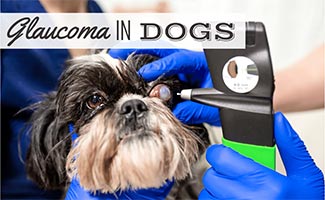
To keep the lights on, we receive affiliate commissions via some of our links. Our review process.

Dogs can develop glaucoma just like people. And this serious eye condition can cause your pup pain, vision loss, and even blindness. Learn more about glaucoma in dogs, including symptoms to look out for, when to see your vet, treatment options, and more.
What Is Glaucoma In Dogs?
Contents
Like human glaucoma, canine glaucoma is an eye disorder that occurs when eye fluid (called aqueous humor) builds up due to inadequate drainage. This fluid buildup increases the intraocular pressure (IOP) within the eye to harmful levels. Over time, this pressure causes damage to the retina and optic nerve, leading to irreversible vision loss and even blindness if left untreated.
What Causes Glaucoma In Dogs?
There are two types of glaucoma: primary (or chronic) glaucoma and secondary glaucoma. Primary glaucoma is caused by inherited abnormalities in the eye’s drainage structure. In contrast, secondary glaucoma is caused by an injury or disease, such as lens damage or dislocation, uveitis (inflammation of the interior eye), tumors, bleeding in the eye, and severe eye infections. While both eyes can be affected in primary glaucoma, it rarely occurs simultaneously.
Predisposed Breeds

According to the Merck Veterinary Manual, glaucoma occurs in about 1.7% of North American dogs, but the rates of hereditary glaucoma in purebred dogs are higher than any other animal species except humans. However, mixed breeds can also develop primary glaucoma. Some of the most popular breeds predisposed to glaucoma include:
- Beagles
- Basset Hounds
- Boston Terriers
- Chow Chows
- Cocker Spaniels
- Great Danes
- Poodles (Toy & Miniature)
- Shar Peis
- Siberian Huskies
Primary glaucoma typically develops between three and seven years of age. However, it can occur at any age. If you have a high-risk breed, you may want to talk to your vet about early screening tests for glaucoma, like ocular ultrasound or electroretinography, particularly if you plan on breeding your pup.
Symptoms Of Glaucoma In Dogs
Early-stage signs of chronic glaucoma in dogs can be very difficult to see because the disease usually progresses slowly over time. However, acute glaucoma in dogs can occur suddenly. If you notice a sudden onset of any of the following signs, your pup requires emergency care.

- Bloodshot whites of the eyes
- Cloudy eyes (sometimes with a bluish tint)
- Swollen or bulging eyes
- Watery discharge
- Dilated pupils
- Lethargy or poor appetite
- Poor vision
- Blindness (end-stage glaucoma)
Diagnosis
To diagnose glaucoma, your vet will examine your pup’s eyes and measure the intraocular pressure in each eye using a tonometer that blows a quick puff of air onto your dog’s cornea. If the pressure is above normal, your vet may run other tests to confirm glaucoma and may refer you to a veterinary ophthalmologist for further tests and treatment.
Glaucoma In Dogs Treatment
Treatment for glaucoma should begin as soon as possible to bring the pressure down and prevent eye damage and vision loss. And, of course, it’s important to treat any injury or underlying health condition that could be causing glaucoma.
Medication
Medical treatment involves glaucoma eye drops for dogs, such as dorzolamide or timolol, to reduce the fluid and lower the eye pressure. Your vet may also prescribe analgesic eye drops to help with the pain. These drops may need to be administered multiple times each day until the pressure returns to normal. However, in many cases of chronic glaucoma, long-term use is necessary to keep the eye pressure down.
Surgery
Surgery is usually necessary for cases that are more severe/advanced or aren’t responding well to eye drops. Several different surgical techniques can help reduce pressure — your veterinary ophthalmologist will determine the best technique for your pup. Dog glaucoma surgery costs can range from $1,000 to $3,000 or more, depending on the type of surgery and whether one or both eyes require surgery.
Eye Removal
Dogs with late or end-stage glaucoma with severe eye swelling or blindness may require eye removal to ease the pain. On average, dog eye removal costs about $1,400.
Ongoing Glaucoma Treatment
Most cases of chronic glaucoma require long-term care to manage the disease. Even after the eye pressure is initially stabilized, it can increase over time. So, regular vet visits to check pressures and to adjust medication are necessary.
Managing Treatment Costs
Many dogs develop eye problems during their lifetime — and these conditions can get extremely expensive to treat. Chronic glaucoma alone requires long-term treatment that can run into thousands of dollars. But if you invest in pet insurance before problems arise, many policies cover a portion of these costly vet bills (as long as it’s not a pre-existing condition). Pet insurance also helps protect you and your dog from unexpected illnesses and accidents. Learn more about pet insurance and whether it’s worth it for you and your pup.
Frequently Asked Questions
Here are some questions our readers often ask about glaucoma in dogs.
Is Glaucoma In Dogs Painful?
Yes, glaucoma can be quite painful for dogs as the eye pressure and swelling increase. Signs that your dog may be experiencing eye pain pawing his eye or rubbing his eye on the floor or other objects. He may also squint, blink a lot, or have sensitivity to light.
Is Glaucoma Preventable?
Are you wondering how to prevent glaucoma in dogs? Primary glaucoma isn’t preventable because it’s genetic. Some cases of secondary glaucoma can be preventable by protecting your dog’s eyes from injury, maintaining your dog’s eye health, and getting prompt veterinary treatment for eye infections or injuries.
Are There Any Dog Glaucoma Home Remedies?
While there’s anecdotal evidence that some home remedies can help dogs with glaucoma, we don’t recommend they replace veterinarian treatment. These home remedies, such as vitamin C, spinach, carrots, fennel, and magnesium, can help overall eye health, but there’s no scientific evidence that they can adequately treat and manage glaucoma. Discuss any supplements you want to give your dog with your veterinarian to ensure their safety.
Glaucoma vs Cataracts In Dogs: What’s The Difference?
A cataract is a cloudy area that forms in the eye’s lens. This area prevents light from generally passing through the lens, causing blurry vision. Glaucoma can also result in cloudy eyes, so it can be challenging to spot the difference in your pup. Glaucoma and cataracts can occur together, and untreated cataracts can cause glaucoma. So if you think your dog is having any eye issues, seek veterinary care so he can get a proper diagnosis and treatment.
How Do I Know When To Put A Dog Down With Glaucoma?
Determining when to euthanize your dog is never an easy decision. If your dog seems to be in a lot of eye pain and has a severely decreased quality of life due to vision loss, you may want to consult with your vet to discuss options and get advice.
Other Dog Eye Conditions
If your dog’s eyes are red and runny, but you’re not sure her symptoms seem like glaucoma, she could have another eye condition. Many conditions can cause red eyes in dogs, including everything from seasonal allergies or a foreign object to canine conjunctivitis or cataracts. If you’re concerned about your pup’s eyes,
Tagged With: Eyes